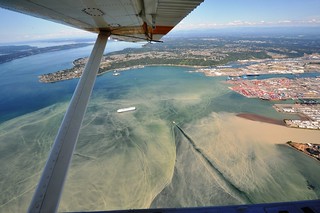 |
| Click here to view the July report |
Blubbery beach bums?
 |
| This seal pup depends on Puget Sound beaches for rest and safety. Photo courtesy of Padilla Bay NERR |
The heat is on!
Through June we saw air temperatures and sunlight that were higher than normal. Recent rain generally improved river flows. However, the Fraser river flow remains extremely low, reducing water exchange with the ocean. Water temperatures are still breaking records, yet dissolved oxygen levels are normal. Go to the report to see our data.
 |
| Glacial flour allows us to see how river plumes float over the saltier water, resulting in complex patterns. Puyallup River plume, Commencement Bay |
Go with the flow
River flow levels for the Puget Sound region have increased recently, compared to the 2015 drought year. Most of the snow is gone however, so meltwater comes primarily from glaciers.
This thin, floating plume of glacial flour from the Puyallup River makes for dramatic imagery! It really highlights how river plumes can be complex and far-reaching.
South Sound inlets full of algae and jellies
Puget Sound algae are thriving with blooms observed in many South Sound inlets. Macro-algae is seen piling up on beaches and drifting in Central Sound. Jellyfish smacks are numerous in Eld and Budd Inlets. Mix together and our marine waters become quite colorful.
 |
| Here in Eld Inlet you can see the red-brown algae swirl dotted with large patches of jellyfish. |
What's under the water?
A mollusc without a shell that looks like a worm? This month, our Eyes Under Puget Sound taxonomists have featured a peculiar creature for the Critter of the Month: The Glistenworm. Learn what makes it shiny and more in our field impressions section of the report.
What's Eyes Over Puget Sound?
 |
| Click through the arrows to scan photos from July's flight, or follow the link to Flickr to see them all. |
Once a month, we take photos of Puget Sound water conditions and turn those out, along with data from our stations, in the monthly Eyes Over Puget Sound report.

No comments:
Post a Comment